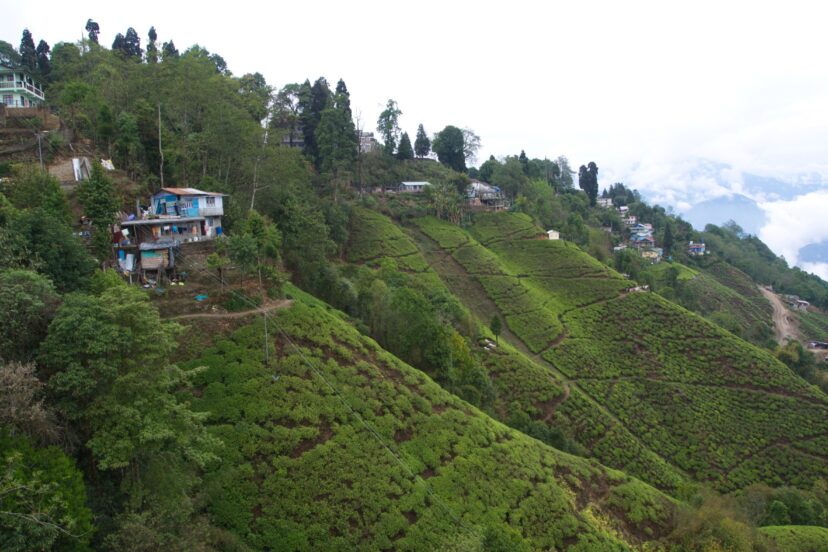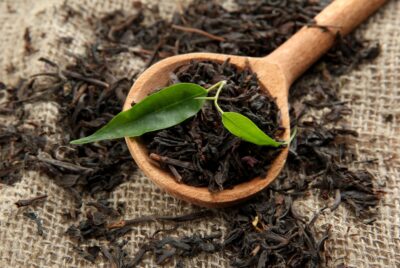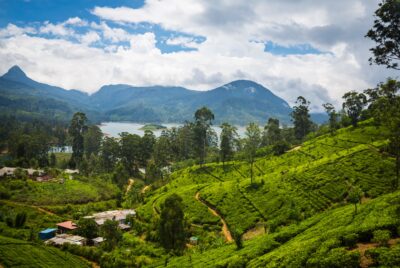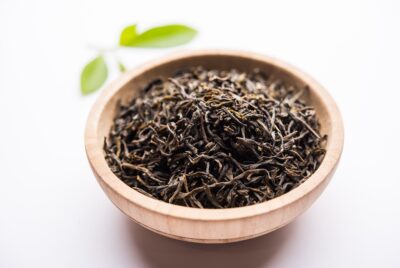Darjeeling Tea: The Complete Guide, An Enthusiast’s Journey
There’s something magical about Darjeeling tea, isn’t there? Often referred to as the “Champagne of Teas,” Darjeeling tea offers a delicate flavor profile that’s both complex and refined. For those who have yet to discover its wonders, consider this your personal guide. Whether you’re a seasoned tea drinker or just starting to explore, Darjeeling tea offers a sensory experience unlike any other. So, what makes this tea so special? Let’s dive in and explore together.
Health Benefits of Darjeeling Tea
Rich in Antioxidants
Darjeeling tea is packed with antioxidants, particularly catechins and flavonoids, which help neutralize free radicals in the body. These antioxidants play a crucial role in reducing oxidative stress; as a result, this reduction helps prevent chronic diseases such as heart disease and cancer. Regular consumption may safeguard your body from harmful effects while promoting overall well-being.
Supports Heart Health
The antioxidants in Darjeeling tea are also beneficial for heart health. They help lower bad cholesterol (LDL) levels and improve blood circulation, reducing the risk of atherosclerosis (hardening of the arteries) and other cardiovascular conditions. Drinking it regularly can help maintain a healthy heart and reduce the risk of heart disease.
Aids in Digestion
Darjeeling tea contains tannins, which have a soothing effect on the digestive system. These compounds can help reduce bloating, relieve indigestion, and promote healthy digestion. Additionally, the natural astringency can help cleanse the palate and aid in the absorption of nutrients.
Enhances Mental Alertness
Darjeeling tea contains caffeine, which can help improve focus and mental alertness. While it has less caffeine than coffee, the amount is still sufficient to provide a gentle energy boost; furthermore, it does so without the jittery side effects often associated with coffee. This makes it an excellent choice for those who need to stay sharp throughout the day.
Promotes Weight Loss
Drinking Darjeeling tea can support weight loss efforts by boosting metabolism and aiding in fat oxidation. The catechins found in the tea are known to increase the body’s ability to burn fat, especially during exercise. Additionally, the tea’s mild diuretic effect can help reduce water retention, contributing to a slimmer appearance.
Supports Immune System Health
Darjeeling tea contains various vitamins and minerals, including vitamin C, which can help boost the immune system.The antioxidants in the tea also contribute to immune support by reducing inflammation; moreover, they enhance the body’s defense mechanisms against infections and diseases.
Improves Skin Health
The antioxidants in Darjeeling tea are not only good for your internal health but, additionally, they benefit your skin by promoting a more youthful appearance and protecting against damage. These compounds help fight the signs of ageing by reducing oxidative stress, which can cause wrinkles, fine lines, and other skin issues. Drinking Darjeeling tea can help promote a youthful complexion and improve skin elasticity.
Reduces Stress and Promotes Relaxation
Darjeeling tea contains theanine, an amino acid known for its calming effects. Theanine helps reduce stress and anxiety by promoting the production of alpha waves in the brain, which are associated with relaxation. Sipping on a warm cup can be a soothing ritual that helps you unwind after a long day.
Regulates Blood Sugar Levels
For those managing diabetes or concerned about blood sugar levels, Darjeeling tea can be a helpful addition to the diet. Some studies suggest that the polyphenols in tea may help regulate blood sugar levels and improve insulin sensitivity, making it a supportive beverage for those looking to maintain stable blood glucose levels.
Supports Bone Health
Darjeeling tea contains small amounts of fluoride, which can help strengthen bones and teeth. Additionally, the antioxidants in the tea may help protect against bone density loss, particularly in postmenopausal women. Regular consumption could contribute to better bone health and reduce the risk of osteoporosis.
These health benefits make Darjeeling tea not only a delightful beverage but also a supportive element in maintaining overall health and well-being. Whether you’re looking to boost your immune system, support heart health, or simply enjoy a relaxing moment, Darjeeling tea offers a wealth of benefits with every sip.
How to Brew the Perfect Cup of Darjeeling Tea
Choosing the Right Water Temperature
The key to brewing a perfect cup of Darjeeling tea lies in the water temperature. For black Darjeeling tea, use water that is just below boiling, around 90-95°C (194-203°F). Green and white Darjeeling teas require cooler water, around 75-80°C (167-176°F), to avoid scalding the delicate leaves.
The Ideal Steeping Time
Steeping time is crucial to achieving the perfect balance of flavor. For black Darjeeling tea, steep for 3-5 minutes. Green Darjeeling tea should be steeped for 2-3 minutes; in contrast, white Darjeeling tea can be steeped for up to 5 minutes to fully extract its delicate flavors. Be sure to adjust the steeping time to your personal taste—longer for a stronger brew, shorter for a lighter cup.
Serving Suggestions
Darjeeling tea is best enjoyed on its own, without milk or sugar, to fully appreciate its complex flavors. However, a slice of lemon can enhance the tea’s natural brightness; additionally, a touch of honey can add a hint of sweetness, creating a balanced flavor. Serve in a fine china cup to elevate the experience—after all, Darjeeling tea deserves to be savored in style.
Different Types of Darjeeling Tea
Black Darjeeling Tea
Black Darjeeling tea, in fact, is the most well-known variety and is typically what most people envision when they hear the term “Darjeeling.” It is the most well-known variety, celebrated for its rich and robust flavor profile. The oxidation process gives this tea its deep color and complex taste, often with notes of muscatel, a sweet and slightly spicy flavor reminiscent of muscat grapes. The best black Darjeeling teas, particularly from the second flush, thus offer a full-bodied experience that is both aromatic and highly prized for their muscatel flavor.
Green Darjeeling Tea
For those who prefer something lighter, more delicate, green Darjeeling tea is an excellent choice. Unlike black tea, green tea undergoes minimal oxidation, which helps preserve its fresh, grassy flavor. This tea has a pale, yellow-green color and a slightly sweet, vegetal taste, making it a refreshing choice for those who prefer a milder tea.
White Darjeeling Tea
White Darjeeling tea is the rarest and most delicate of all Darjeeling teas. Made from the youngest leaves and buds, this tea is minimally processed to retain its natural flavors. The result is a light, subtle brew with notes of honey, melon, and a hint of floral sweetness. It’s a true connoisseur’s tea, perfect for those who appreciate subtlety and elegance.
Oolong Darjeeling Tea
Oolong Darjeeling tea sits between black and green tea in terms of oxidation. This semi-oxidized tea offers a unique flavor profile that combines the best of both worlds. Darjeeling Oolong is known for its smooth, rich taste with a floral aroma and a slightly sweet aftertaste. It’s a flexible tea that can be enjoyed at any time of the day.
Darjeeling White Peony Tea
A specific type of white Darjeeling tea, White Peony, or Bai Mu Dan, is made from the unopened buds and the first two leaves of the plant. This tea has a slightly stronger flavor than other white teas, with a sweet, nutty taste and a hint of floral undertones. It’s a delicate and refreshing option that appeals to both white tea enthusiasts and those new to this variety.
Darjeeling Masala Chai
While traditional Darjeeling tea is often enjoyed on its own, similarly, Darjeeling Masala Chai is a spiced version that adds a unique twist to the classic flavor. It blends black Darjeeling tea with a mix of spices such as cardamom, cinnamon, ginger, and cloves. The result is a warming, aromatic brew that’s perfect for those who enjoy a bit of spice in their tea.
Darjeeling Hand-rolled Tea
Hand-rolled Darjeeling tea is a specialty tea that involves a meticulous process where the leaves are carefully rolled by hand. This process ensures that the delicate flavors are preserved, resulting in a tea that is smooth, aromatic, and full of subtle complexities. Hand-rolled teas are often made in small batches and are highly prized for their quality and craftsmanship.
Darjeeling Green Pearl Tea
Green Pearl Darjeeling tea is a rare and unique variety where the leaves are rolled into small, tight pearls. When steeped, these pearls unfurl, releasing a fresh, floral aroma and a delicate, sweet flavor. This tea is light and refreshing, with a smooth texture that makes it a perfect choice for those who appreciate the finer aspects of tea.
Darjeeling Clonal Tea
Clonal Darjeeling tea is produced from specific clones of the tea plant that have been selected for their superior quality and unique characteristics. These teas often have a more refined flavor profile, with distinct notes that can range from floral to fruity. Clonal teas are highly sought after by tea connoisseurs who are looking for something special and unique.
Organic Darjeeling Tea
For those who prefer their tea without any synthetic chemicals or pesticides, Organic Darjeeling tea is the perfect choice. Grown in accordance with organic farming practices, it offers the pure, unadulterated flavor of Darjeeling. It’s a healthier option for both you and the environment; moreover, it does so without compromising the rich, complex flavors that Darjeeling tea is known for.
Moonlight Darjeeling Tea
Moonlight Darjeeling tea, also known as “Silver Tips,” is a rare and exquisite type of tea that is, furthermore, harvested under the light of the moon, adding to its unique appeal. This tea is made from the youngest leaves and buds, which are covered with fine, silver hairs. The tea has a delicate, sweet flavor with hints of honey and a light, floral aroma. It’s a truly unique tea that offers a one-of-a-kind tasting experience.
These varieties showcase the diversity within the Darjeeling tea category, allowing enthusiasts to explore a wide range of flavors and experiences, each with its own distinct characteristics.
The Unique Terroir of Darjeeling
Geography and Climate
Darjeeling, located in the foothills of the Himalayas, provides the perfect environment for growing tea. The region’s high elevation, combined with its misty, cool climate, gives Darjeeling tea its distinctive character. The tea gardens here are often shrouded in fog, which slows down the growth of the tea leaves, allowing them to develop rich, complex flavors.
Elevation and Its Impact
The elevation of Darjeeling tea gardens ranges from 600 to 2,000 meters above sea level. This variation in altitude significantly impacts the flavor of the tea. Specifically, higher elevations produce tea that is lighter and more floral, whereas lower elevations yield a bolder, more robust brew. The unique combination of altitude, soil, and climate is what gives Darjeeling tea its prized aroma and taste.
The Distinctive Flavors of Darjeeling Tea
The Influence of Harvest Seasons
Darjeeling tea is harvested four times a year, with each season imparting its own distinct flavor profile. Understanding these nuances is key to fully appreciating its depth and variety.
First Flush: The Spring Harvest
The first flush Darjeeling tea, harvested between late February and April, is known for its light, floral flavor. The leaves are young and tender, producing a pale, golden liquor with a fresh, crisp taste. As a result, this is the most sought-after Darjeeling tea, often compared to fine white wine.
Second Flush: The Summer Harvest
The second flush Darjeeling tea occurs from May to June, and the tea from this harvest is richer and more full-bodied. It has a unique “muscatel” flavor, reminiscent of muscat grapes, with a slightly fruity, spicy undertone. This is the classic Darjeeling flavor that many enthusiasts seek out.
Monsoon Flush: The Rainy Season
Harvested during the monsoon season from July to September, the monsoon flush, consequently, produces tea that is less delicate and more robust. The leaves are thicker and produce a stronger, darker brew, which is often used in blends or for making chai.
Autumn Flush: The Final Harvest
The autumn flush Darjeeling tea, harvested in October and November, produces tea with a well-rounded, mellow flavor. The leaves have matured, resulting in a tea that is less astringent and more balanced, with a deep amber color.
The Art of Tea Tasting
Tasting Darjeeling tea is an art in itself. Each sip reveals layers of flavor that unfold gradually on your palate. To truly appreciate the tea, it’s essential to take your time by savoring the aroma before taking a sip, and then allowing the flavors to gradually unfold in your mouth. This is not a tea to be rushed—it’s a tea to be experienced.
The Process of Darjeeling Tea Production
From Plucking to Withering
The journey from garden to cup begins with the careful plucking of the tea leaves. Only the top two leaves and a bud are selected, ensuring the highest quality. Once plucked, the leaves are then spread out to wither, thereby reducing their moisture content and subsequently preparing them for the next step in the process.
Rolling and Oxidation
After withering, the leaves are rolled to release their natural juices, which initiates the oxidation process. Oxidation is what gives black Darjeeling tea its characteristic flavor and color. The level of oxidation is, therefore, carefully controlled to achieve the desired flavor profile, with some teas being more oxidized than others.
Firing and Sorting
Once the desired level of oxidation is reached, the leaves are fired to halt the process and lock in the flavor. The tea is then sorted by size and quality, with the finest leaves reserved for premium grades. This meticulous process ensures that every cup is of the highest standard.
Pairing Darjeeling Tea with Food
Sweet and Savory Combinations
Darjeeling tea pairs beautifully with a wide variety of foods. Its delicate flavor makes it a perfect match for light, sweet treats like scones and shortbread, as well as savory dishes like smoked salmon or quiche. For a true gourmet experience, try pairing with fine cheese—the tea’s subtle notes complement the richness of the cheese beautifully.
Ideal Times to Enjoy Darjeeling Tea
While Darjeeling tea can be enjoyed at any time of day, it is particularly well-suited to mid-morning or afternoon. The light, refreshing flavor makes it an excellent choice for a mid-morning break, while the more robust second flush is perfect for an afternoon pick-me-up.
Tips for Buying Authentic Darjeeling Tea
Recognizing Authentic Labels
When buying Darjeeling tea, look for the “Darjeeling” logo on the packaging, which certifies that the tea is genuine and has been grown in the Darjeeling region. Be wary of imitations—only tea grown in this specific area can be called Darjeeling tea.
Trusted Sources and Retailers
To ensure you’re getting the best quality Darjeeling tea, buy from reputable sources. Many specialty tea shops and online retailers offer a wide range of Darjeeling teas, often directly sourced from the tea gardens. Some trusted brands include Twinings, Teabox, and Mariage Frères.
Tips and Hints for Enjoying Darjeeling Tea
Experiment with Steeping Times
The flavor of Darjeeling tea can vary significantly based on how long you steep it. Start with the recommended time (3-5 minutes for black Darjeeling, 2-3 minutes for green, and up to 5 minutes for white), but don’t be afraid to adjust it to suit your taste. A shorter steeping time will yield a lighter, more delicate brew, while a longer steeping time will produce a stronger, more robust cup.
Use Fresh, Filtered Water
The quality of water you use can greatly affect the taste of your tea. For the best flavor, it’s important to use fresh, filtered water when brewing your tea. Avoid distilled water, as it lacks the minerals that can enhance the taste of the tea, and steer clear of water that has been boiled multiple times, as it can make the tea taste flat.
Preheat Your Teapot and Cups
To keep your tea warm for longer and to ensure even brewing, preheat your teapot and cups by rinsing them with hot water before brewing. This simple step can make a big difference in your tea-drinking experience, helping to maintain the optimal temperature of the tea.
Pair with Complementary Foods
Darjeeling tea pairs wonderfully with a variety of foods. Try serving it with light, buttery pastries like scones or shortbread, or with savory snacks like cucumber sandwiches. The second flush Darjeeling, with its muscatel flavor, pairs particularly well with rich cheeses and smoked meats.
Explore Different Flushes
Don’t limit yourself to just one type of Darjeeling tea. Each flush (harvest season) offers a unique flavor profile, from the light and floral first flush to the rich and robust second flush. Exploring these different flushes can enhance your appreciation for the diversity of Darjeeling tea.
Try Cold Brewing
For a refreshing twist, try cold brewing. Simply steep the tea leaves in cold water and refrigerate for 6-12 hours. The result is a smooth, mellow tea with a subtly different flavor profile than when brewed hot. This method is perfect for warm weather or for a lighter, refreshing tea experience.
Don’t Overdo the Sweeteners
Darjeeling tea has a naturally delicate and complex flavor that can be easily overwhelmed by too much sugar or honey. If you prefer your tea sweetened, start with just a small amount and adjust to taste. Consider using natural sweeteners like honey or agave, which complement the tea’s flavor without overpowering it.
Add a Slice of Lemon
A slice of lemon can enhance the brightness and floral notes of Darjeeling tea, especially the first flush. The acidity of the lemon balances the tea’s natural sweetness, adding a refreshing twist. However, avoid adding milk to Darjeeling tea, as it can dull its delicate flavors.
Experiment with Blends
While Darjeeling tea is often enjoyed on its own, it can also be blended with other teas or herbs for a unique flavor experience. Try mixing Darjeeling with a hint of jasmine or rose petals for a floral blend, or add a touch of mint for a refreshing twist.
Some excellent options include:
- Jasmine Tea: Jasmine Tea and Jasmine Green Tea add a floral, fragrant note to the delicate flavor of Darjeeling.
- Earl Grey: The citrusy bergamot complements Darjeeling’s muscatel notes.
- Mint Tea: A refreshing addition that balances Darjeeling’s subtle sweetness.
- Chamomile: Blends well with Darjeeling for a soothing, slightly floral experience.
- Assam Tea: Combines Assam’s robust flavor with Darjeeling’s light, floral character for a balanced cup.
Experimenting with these blends can lead to delightful, nuanced flavors!
Serve in Fine China
Darjeeling tea is often considered a luxury, so why not serve it in fine china cups? The thin rim of a china cup allows the tea to flow smoothly, enhancing the tasting experience. Plus, it adds an element of elegance to your tea ritual.
Brew Multiple Infusions
Darjeeling tea, especially high-quality leaves, can often be steeped multiple times. Each infusion may reveal different nuances of flavor. Start with a shorter steeping time for the first brew, and slightly increase the time for each subsequent infusion.
Host a Darjeeling Tea Tasting
If you’re a Darjeeling tea enthusiast, consider hosting a tea tasting event. Invite friends over to sample different flushes and varieties of Darjeeling tea. This can be a fun and educational way to explore the wide range of flavors Darjeeling has to offer.
Explore Different Brewing Methods
While the traditional method of brewing Darjeeling tea involves steeping in hot water, don’t be afraid to explore other methods. For example, you can use a French press for a more controlled infusion or a gaiwan (a traditional Chinese lidded bowl) for a more ceremonial experience.
Keep a Tea Journal
If you’re serious about your Darjeeling tea journey, consider keeping a tea journal. Record the different types of Darjeeling tea you try, the brewing methods you use, and your tasting notes. This can help you refine your preferences and deepen your appreciation for this exquisite tea.
These additional tips and hints are designed to help you get the most out of your Darjeeling tea experience, whether you’re a seasoned tea drinker or just beginning your exploration.
Storing Darjeeling Tea: Best Practices
Ideal Storage Conditions
To preserve the freshness and flavor of your Darjeeling tea, store it in an airtight container, away from light, heat, and moisture. A cool, dark cupboard is ideal. Avoid storing tea in the refrigerator, as the moisture can cause the leaves to lose their flavor.
Avoiding Common Mistakes
One common mistake is storing tea near strong-smelling foods or spices, as the tea can absorb these odors. Another is leaving the tea exposed to air for too long, which can cause it to become stale. By following these simple storage tips, you can ensure that your Darjeeling tea stays fresh and flavorful for months.
Final Thoughts
Darjeeling tea is more than just a beverage—it’s a journey of flavors, history, and culture. From its unique terroir to its delicate harvesting process, every cup of Darjeeling tea tells a story. Whether you prefer the light, floral notes of the first flush or the rich, muscatel flavor of the second flush, there is a Darjeeling tea for every palate. So take a moment, brew yourself a cup, and savor the essence of Darjeeling—it’s a taste of the Himalayas in every sip.
FAQs
What makes Darjeeling tea different from other teas?
Darjeeling tea is unique because of its specific growing conditions in the Darjeeling region, which give it a distinct flavor profile that is often described as floral, fruity, and muscatel.
How should I store Darjeeling tea to keep it fresh?
Store Darjeeling tea in an airtight container, away from light, heat, and moisture. A cool, dark cupboard is the best place to keep it fresh.
Can I add milk or sugar to Darjeeling tea?
While Darjeeling tea is best enjoyed on its own to appreciate its complex flavors, you can add a slice of lemon or a touch of honey if you prefer. Adding milk is generally not recommended, as it can overpower the delicate taste.
What is the best time of day to drink Darjeeling tea?
Darjeeling tea is versatile and can be enjoyed at any time of day, but is particularly refreshing in the mid-morning or afternoon.
Is Darjeeling tea good for health?
Yes, Darjeeling tea is rich in antioxidants, which can help improve heart health, aid digestion, and provide other health benefits when consumed regularly.




